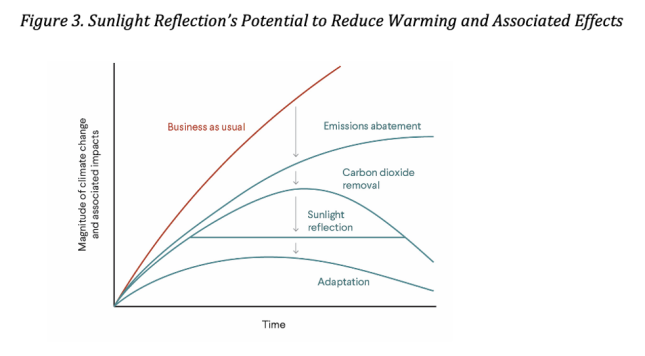-
Serious About Climate Change? Put All Options on the Table
May 17, 2022 By Ania Zolyniak
The intensifying enmity between the United States and Russia arising from the war in Ukraine may obscure a fundamental and durable milestone in climate science: One of the most significant pieces of evidence substantiating a shared major security concern—anthropogenic climate change—was the result of United States, French, and Russian cooperation. Ice cores drilled at Russia’s Antarctic Vostok Station provided among the most incontrovertible proof linking human greenhouse gas (GHG) emissions to increasing atmospheric temperatures—over two decades ago.
Indeed, although “the climate emergency” foretold by these ice cores may be increasingly present in our lives and our world, neither it nor its vast implications are new. Recent chilling reports of a looming mass marine extinction and rapidly escalating frequencies of climate-induced disasters add to a growing mountain of articles on record-breaking temperatures and extreme weather dating back to the last century.
The difference now is that time is fast running out to take positive steps and avoid climate-induced environmental calamities. As economies make slow progress on decarbonization (or even reverse it), Earth remains on a crash course toward potentially irreparable planetary harm, the consequences of which are already materializing.
Therefore, policymakers and scientists can ill-afford to not consider all possible options for managing climate risk—even those that have long been eschewed by climate diplomats and decision-makers. Doing so, however, will require drastically improving the knowledge and governance of one such potential, and promising, strategy: sunlight reflection.
Current Strategies and Their Limits
Countries currently have three approaches at their disposal to manage climate risk: emissions reductions, carbon dioxide removal (CDR), and adaptation. But Stewart M. Patrick—a Senior Fellow at the Council on Foreign Relations—offers a fourth option in a new report: “Reflecting Sunlight to Reduce Climate Risk.”
Patrick writes that “the ultimate solution to the climate emergency is a combination of deep decarbonization” and atmospheric GHG removal. Unfortunately, however, progress on the former strategy has been distressingly insufficient. Moreover, even if economies do manage to decarbonize, the 419 parts per million of carbon dioxide (CO2) in today’s atmosphere means that a degree of warming is already baked in.
Regarding the latter, mechanical and natural CDR could help prevent temperatures from rising more than 1.5°C above preindustrial levels, but both approaches will take years to reach necessary scale. Patrick observes that restoring atmospheric CO2 concentrations to preindustrial levels would require removing the equivalent of about “thirty cubic miles of solid black carbon—a volume roughly comparable in size to Mount Rainier.”
Patrick describes the resilience- and capacity-building efforts involved in adaptation strategies as being “essentially palliative measures” that would only help humanity survive a changing climate without doing anything to avert it. Furthermore, not all climate effects can be foreseen or preempted. Some “will simply need to be borne.”
The Case for Sunlight Reflection
Considering these shortcomings and challenges, Patrick presents sunlight reflection as a fourth potential strategy for managing climate risk. Sunlight reflection, or solar climate intervention (SCI), is a catch-all term for various techniques of reflecting about one percent of sunlight back into space to counteract its warming effects on GHGs. Patrick observes that doing so could offer “a technologically plausible, potentially rapid, and relatively inexpensive way” of slowing global warming.
Far from a decarbonization substitute, SCI presents an opportunity to deploy a supplementary means of mitigating climate hazards as countries work to stabilize (and reduce) atmospheric GHG concentrations. In other words, sunlight reflection could be the aspirin the world needs to keep its climate fever under control as humans make steady progress towards a cure.
Despite SCI’s potential value as a stopgap strategy that “shave[s] the peak” of temperature increases and their ramifications, the approach does have its detractors. Some critics fear that it could trigger a moral hazard that might grant polluters a blank check to continue their destructive ways. Others cite its potential unintended consequences, including impacts on the delicate systems of the planetary environment. Patrick argues that while these concerns warrant study, they must be weighed against the (un)known dangers of climate change.
Unfortunately, no such comparative risk assessment is currently possible. Governments have avoided even discussing SCI openly—and their understanding of sunlight reflection’s impacts, feasibility, and risks remains woefully inadequate.
The Intergovernmental Panel on Climate Change acknowledged that when compared with climate hazards, far fewer studies have assessed sunlight reflection’s consequences—or its potential to reduce climate risk. Aggravating the matter further, world leaders and researchers lack even a framework for governing sunlight reflection research and possible deployment and are flying blind into a storm supercharged by increased evaporation and warmer air.

This gap in SCI knowledge and governance not only robs future generations of a fighting chance to survive the post-carbon transition, but also invites uninformed decisions, geopolitical mistrust, and dangerously ill-designed experiments and deployments. Swiftly addressing SCI information inadequacies, as well as creating international mechanisms to oversee future research and potential implementation, could remedy this situation.
Forging a Responsible Path Forward
Given its ample resources and legacy of cooperative research and innovation, the United States is uniquely positioned to jumpstart increased global scientific and policy inquiry into sunlight reflection. Establishing a robust, transdisciplinary national sunlight reflection research program, steeped in international collaboration, would be a critical first step in doing so. Patrick proposes that such a program should also promote informed decision-making among U.S. policymakers and aim to allay concerns of U.S. dominance or abrogation of climate commitments.
The United States should also marshal efforts to establish multilateral governance arrangements that equip nations with high-quality, consensus-based, scientific assessments and allow them to collectively evaluate the desirability of SCI and take decisions regarding its potential deployment. Patrick recommends that, among other policy initiatives, the U.S. use its May 2022 UN Security Council presidency to introduce the topic before the body’s membership and make SCI deliberations a standing agenda item in annual G7 and NATO meetings.
The verdict has been “in” on the climate crisis for decades. What remains uncertain is whether humanity is ready and willing to do what is called for—and all that is called for—to address it.
Ania Zolyniak is the research associate for the International Institutions and Global Governance program at the Council on Foreign Relations.
Sources: Nature; World Politics Review; Science; United Nations; The New York Times; Reuters; Council on Foreign Relations; Exploratorium; Stanford Social Innovation Review; National Academies Press; Polity; C2G; IPCC; Royal Society Publishing; Scientific American; White House Office of Science and Technology Policy; AAAS; Tellus.
Photo credit: Image of Earth taken by crew members aboard the International Space Station, courtesy of Flickr user NASA Johnson.
 A Publication of the Stimson Center.
A Publication of the Stimson Center.




